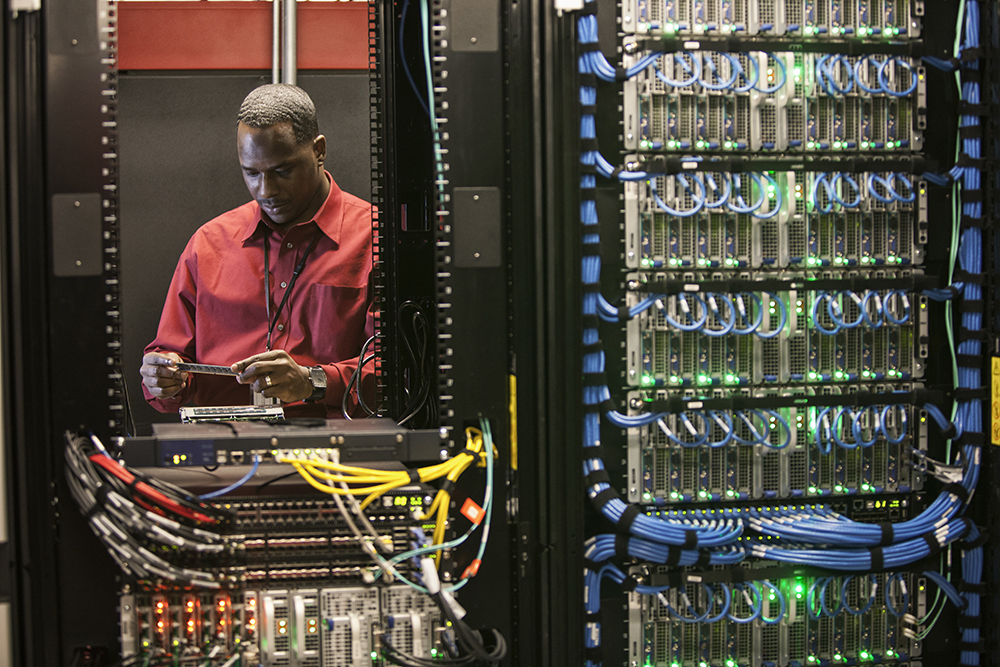IT infrastructure support is an essential part of running a successful business. It is the backbone of your company’s operations; without it, you would not be able to run your business.
However, it is also a complex area of technology that requires specialized knowledge and skills to manage effectively. If you want to expand your business into this field, you should consider taking a course in IT infrastructure support.
Table of Contents
What Is IT Infrastructure Support?

The term “infrastructure” refers to all aspects of the physical environment where computers or other devices operate. This includes power supplies to data centers, servers, networking equipment, storage systems, software applications, operating system platforms, and more. The goal of any IT infrastructure support provider is to ensure that these components work together seamlessly to provide uninterrupted service to users.
In addition to providing technical services, IT infrastructure support providers must have extensive experience with their specific areas of expertise.
For example, if you need help setting up new hardware or installing software on existing machines, you will want someone who has done this before. You may even choose to hire multiple specialists depending on what type of problem you encounter.
If you own a small business, the chances are good that you do most of the day-to-day tasks yourself. However, when something goes wrong, no one is around to fix it. To avoid downtime, you need to make sure that you know how to troubleshoot problems and repair them.
This means knowing which tools and resources are available and being familiar with basic computer maintenance techniques such as cleaning out temporary files and defragmenting hard drives.
You might find that hiring a professional helps save time and money by avoiding costly mistakes. For instance, many businesses use cloud computing solutions because they offer easy access to high-quality remote server management tools at a low cost. These companies often employ highly skilled technicians who manage large network servers. They can quickly diagnose issues and resolve them remotely using sophisticated monitoring programs.
What Are The Three Primary Components Of IT Infrastructure?

Any IT infrastructure has three main parts: Hardware, Software, and Network Services. Each component plays a vital role in ensuring that your network runs smoothly. Let’s take a look at each one individually.
Hardware
Your hardware consists of the equipment used to store information and process instructions. Examples include desktop PCs, laptops, tablets, smartphones, printers, scanners, routers, modems, faxes, monitors, keyboards, mice, speakers, cameras, projectors, televisions, external hard disks, flash memory cards, USB sticks, etc.
Software
Your software consists of the programs installed on your device to perform various functions. It could be an application like Microsoft Word or Adobe Photoshop or a web browser like Google Chrome or Mozilla Firefox.
A network provides connectivity between different devices within your organization. It allows people to share documents, photos, music, videos, presentations, spreadsheets, databases, emails, instant messages, voice calls, video conferences, online meetings, and much more.
Why Should I Hire An IT Infrastructure Support Provider?

There are several reasons why you should look for an experienced IT infrastructure support provider:
- Expertise – When choosing an IT infrastructure support provider, you want to select someone who specializes in working within your industry. While some think having general IT support is enough, this isn’t always true. Many industries require unique skill sets that only experts possess.
- Experience – As mentioned above, you don’t just get what you pay for. There’s nothing worse than paying top dollar for a solution that doesn’t deliver results. By selecting an expert, you’ll receive reliable advice backed by years of hands-on experience.
- Reliability – If you’re looking for a company that provides 24/7 emergency response, you won’t be happy with anything less. A reputable IT infrastructure support provider offers round-the-clock coverage via phone, email, chat, and live web meetings.
- Availability – Even though technology changes rapidly, certain technologies remain relevant over long periods. Your IT infrastructure needs to keep pace with those trends. It also requires regular upgrades to stay secure and efficient. This is where a qualified IT infrastructure support provider comes into play. Their team members are constantly learning about emerging security threats so they can provide proactive recommendations.
- Cost Savings – The best way to reduce costs is through efficiency. That’s what outsourcing does. Outsourcing allows you to focus more on growing your business while letting professionals handle routine operations like network administration, data backup, and system updates.
- Scalability – Most organizations grow along with their success. You may have started with a single employee, but now you’ve expanded to multiple locations or nationwide. To accommodate these growth opportunities, you must ensure that your IT infrastructure has room to grow without breaking down under pressure. Only a seasoned IT infrastructure support provider will understand your current capacity and recommend ways to increase it.
What Are Some Of The Best Ways To Select An IT Infrastructure Support Provider?

- Ask For References – When choosing an IT infrastructure support provider, request references before signing a contract. These should include names, contact information, and job titles. Please note how many clients each person manages and whether they work remotely. Also, find out if the individual has worked at previous companies.
- Check Online Reviews – Review sites like Yelp and Angie’s List offer valuable insight when researching prospective IT infrastructure support providers. Read user comments posted in forums and blogs related to the industry. Pay special attention to negative feedback because this could indicate poor quality services.
- Interview Potential Providers In-Person – Before hiring anyone, meet them face-to-face. During the interview process, discuss your organization’s goals and expectations. Determine who will manage the project and why. Discuss budget requirements and determine how much money you’ll spend per month. Be clear about all terms and conditions before making a final decision.
- Consider A Long-Term Relationship With One Company – If you’re looking for a one-time solution, consider using a managed service provider. MSPs specialize in providing ongoing IT infrastructure support. They typically charge monthly fees based on usage rather than hourly rates. However, some MSPs do offer discounts for large contracts.
- Hire Someone Who Has Experience Managing Similar Projects – While most think of networking experts when considering IT infrastructure support, not everyone can handle network issues. Instead, look for someone who specializes in managing servers, operating systems, and software applications. This way, you know your company’s data won’t be lost due to system crashes.
- Choose A Service That Offers 24/7 Technical Assistance – Many businesses don’t realize that having access to technical assistance doesn’t just apply during business hours. It also applies after regular working hours. After all, what happens when something goes wrong while you’re sleeping? You need someone to help fix it immediately! Therefore, ensure that your chosen IT infrastructure support provider offers round-the-clock tech support.
- Find Out About Their Level Of Training And Certification – Most reputable IT infrastructure support providers have undergone extensive training programs. As part of their education, these professionals must pass exams administered by organizations such as CompTIA. Certifications prove that individuals possess certain skills and knowledge required to perform specific tasks.
- Get An Estimate From Several Vendors – Once you’ve narrowed your list of potential candidates, ask each vendor for pricing estimates. Compare prices and choose the best deal. Remember: Don’t settle for anything less than excellent value.
- Make Sure Your Contract Is Written Clearly – When choosing an IT infrastructure support provider, make sure they clearly explain everything before signing any agreements. Ask questions if there’s anything unclear or confusing. Also, read through the contract carefully before agreeing to its terms. Some companies may try to sneak additional charges into the agreement without telling you upfront. Avoid those types of shady practices.
What Is Infrastructure Management?

Infrastructure management refers to managing computer resources within your organization. It involves monitoring system health, maintaining security settings, updating software patches, backing up files, performing routine maintenance tasks, and other similar activities. IM can affect both physical and virtual machines. Physical machine management typically requires specialized skills, while virtual machine management usually falls under the purview of network administrators. However, some organizations use one group to perform both functions. The following are examples of typical responsibilities performed by an IM team:
- Monitoring System Health – Monitor system logs, run diagnostic tests, check file integrity, identify potential threats, resolve issues, and ensure everything works correctly.
- Updating Security Settings – Update firewall rules and antivirus definitions, patch vulnerabilities in Windows or Linux OSes, apply updates to anti-malware programs, and ensure proper firewalls and intrusion prevention systems configuration.
- Performing Routine Tasks – Perform backups, back up user profiles, restore deleted items from a previous date, clean out temporary internet files, remove old log entries, delete unused images, defragment disks, optimize disk space, recover lost passwords, and much more.
- Maintaining Network Connectivity – Ensure connectivity between devices through routers, switches, hubs, wireless networks, VPN connections, and so forth.
- Managing Virtual Machines – Manage VMs running different operating systems, configure networking options, install new operating systems, troubleshoot problems, migrate VMs among hosts, move VMs into production environments, and maintain performance levels.
- Other responsibilities include configuring email servers, setting up printers, installing computer applications, creating custom scripts, writing documentation, training users, providing technical assistance, and resolving related issues.
How Does Infrastructure Affect Businesses?

The importance of having reliable technology cannot be overstated. If you don’t have enough bandwidth for your employees’ needs, some users won’t get the required service. This can lead to frustration among customers and staff alike. Without the proper IT infrastructure support, you are almost guaranteed to have mishap after mishap affecting your business negatively.
It’s also important to note that not every company uses its computers in precisely the same way. Some prefer to work from home, while others spend hours sitting behind desks in open offices. So make sure that whatever infrastructure support solution you choose can accommodate the types of workers you have.
We Provide Top IT Infrastructure Support Services
Infinity Solutions’ IT infrastructure services include:
- Server Management & Monitoring – We manage server hardware and software configurations on behalf of our clients. In addition, we monitor performance metrics like CPU usage, memory utilization, disk space, etc., ensuring optimal daily operations.
- Network Management and Infrastructure Maintenance – We maintain client networks with a wide range of top-of-the-line network devices. We install physical hardware, networking devices, networking components, and networking hardware if necessary. We then configure them correctly and troubleshoot problems with your technology infrastructure.
- Application Installation & Configuration – We create custom applications tailored specifically to meet the needs of individual clients. This includes installing operating systems, configuring servers, setting permissions, creating databases, and more.
- Data Backup Solutions – We offer backup data solutions and capacity planning designed to protect critical information stored on computers, mobile phones, tablets, hard drives, flash media, etc.
- Disaster Recovery Planning – We work closely with clients to develop comprehensive disaster recovery plans. These plans outline what steps should be taken during times of emergency. They also provide guidelines regarding when it’s appropriate to take action.
- Web Hosting Service Providers – We help businesses set up web hosting accounts. With these accounts, clients can access tools that allow them to build websites, upload content, send emails, etc.
- Website Design & Development – We design and develop customized websites using industry-standard technologies such as HTML5, CSS3, PHP, MySQL, WordPress, Joomla!, Drupal, Magento, OpenCart, PrestaShop, Zen Cart, and many others.
- Software Licensing & Subscription Renewals – We handle licensing and renewal processes for various software packages, including Microsoft Office 365, Adobe Creative Cloud Suite, SentinelOne, Teams, Slack, etc.
Cloud Infrastructure And Support Services

The cloud computing model has become increasingly popular over recent years due to its ability to provide flexible solutions that meet business needs without requiring significant upfront investments. In addition, it offers several benefits over traditional infrastructure, like cost savings, scalability, mobility, flexibility, and reliability. These features have made the adoption rate of cloud services very high across industries.
This trend shows no signs of slowing down anytime soon as businesses realize how beneficial these services are for their operations. As such, many companies now rely heavily on private cloud technology to improve productivity and efficiency. Cloud service providers offer various products and services, including storage, backup, disaster recovery, web hosting, application development, database administration, content delivery, etc. They also provide managed services that allow customers to focus on core competencies instead of worrying about day-to-day operational concerns.
IT Infrastructure Management Services And Tools

As mentioned earlier, numerous tools are available today to help organizations with business functions and effectively manage their IT infrastructures. Some examples include:
* Application Performance Monitoring – APM helps monitor software processes within your organization’s network environment. It allows you to track resource consumption, detect bottlenecks, and analyze response times. You can use this information to identify areas where improvements must be implemented to increase system availability and reduce downtime.
* Backup & Recovery Software – Backups ensure data integrity while recovering ensures consistency after a failure or loss. There are two main categories of backup methods: full and incremental. Full backups contain all the data stored on a computer, whereas incremental ones only store changes since the last backup. Both require regular maintenance to keep them effective.
* Data Protection Solutions – Data protection refers to backing up important files so they may be recovered if lost. Depending on the type of file you want to protect, you should choose from physical media, tape drives, external hard disks, USB flash drives, etc.
* Network Security – Network infrastructure security protects computers connected to networks against unauthorized access. Common attacks include viruses, worms, spyware, Trojan horses, denial of service attacks, and distributed DoS. To prevent these threats, you must implement proper firewalls, antivirus programs, intrusion detection/prevention systems, and other technologies
* Storage Area Networks – SANs enable multiple servers to share resources through shared disk space. Using SANs, you can easily add additional capacity when needed. However, using SANs comes with certain drawbacks. They require specialized hardware and expertise to set up correctly. Second, they increase management costs because each server needs individual configuration settings. Third, they do not scale well; adding more devices means buying new equipment. Finally, it adds complexity to existing applications.
Wrapping Up
If there’s one thing you don’t want to do, it’s skimp on IT infrastructure support. The cost savings that come with an efficient IT infrastructure will far outweigh any short-term expenses incurred by investing in better technology. In addition, as we’ve seen throughout this article, many aspects of IT infrastructure have been discussed, including networking, storage, operating systems, application development, disaster recovery, and much more. This has given us a broad understanding of how various components work together to create a successful computing platform. We hope you found our guide useful, and as always, if you need assistance, send us a message or leave a comment below!



Trackbacks/Pingbacks